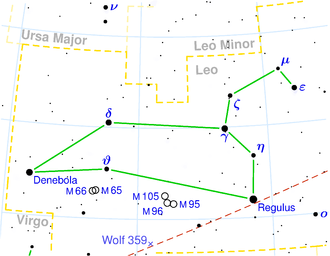NGC 3937
| Galaxy NGC 3937 |
|
|---|---|

|
|
| SDSS recording | |
| AladinLite | |
| Constellation | lion |
|
Position equinox : J2000.0 , epoch : J2000.0 |
|
| Right ascension | 11 h 52 m 42.6 s |
| declination | + 20 ° 37 ′ 53 ″ |
| Appearance | |
| Morphological type | S0- |
| Brightness (visual) | 12.5 mag |
| Brightness (B-band) | 13.5 likes |
| Angular expansion | 1.8 ′ × 1.6 ′ |
| Position angle | 15 ° |
| Surface brightness | 13.7 mag / arcmin² |
| Physical data | |
| Redshift | 0.022242 ± 0.000090 |
| Radial velocity | 6668 ± 27 km / s |
|
Stroke distance v rad / H 0 |
(296 ± 21) x 10 6 ly (90.7 ± 6.4) Mpc |
| history | |
| discovery | Wilhelm Herschel |
| Discovery date | April 27, 1785 |
| Catalog names | |
| NGC 3937 • UGC 6851 • PGC 37219 • CGCG 127-088 • MCG + 04-28-081 • 2MASX J11524264 + 2037527 • GC 2596 • H III 389 • h 1003 • LDCE 0836 NED054 | |
NGC 3937 is a lenticular galaxy of Hubble type e-S0 in the constellation Leo , the estimated 296 million light-years from the Milky Way 's center.
The galaxy was discovered on April 27, 1785 by the astronomer Wilhelm Herschel with his 18.7-inch reflecting telescope.
